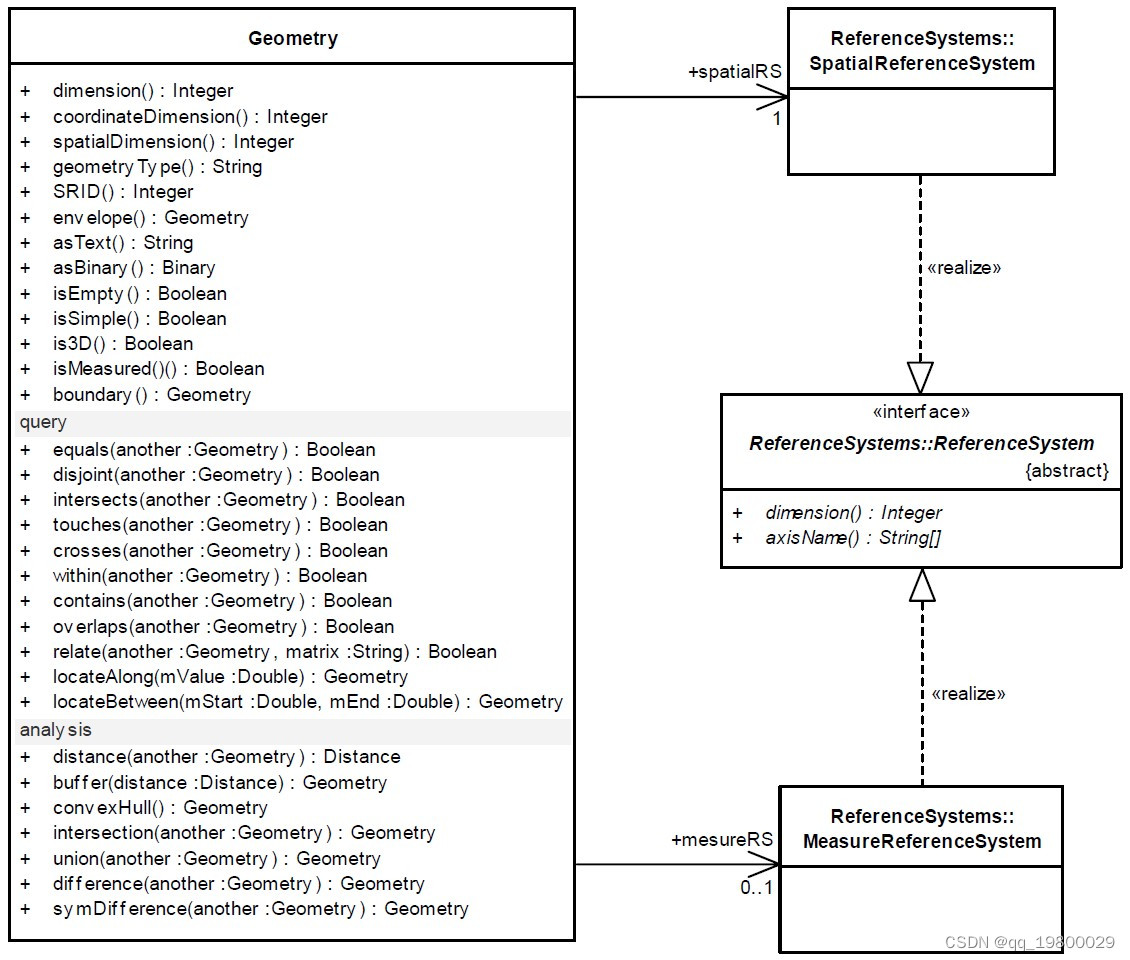一、几何对象模型概述
独立于计算机平台之外的、天然适用于分布式计算的、统一使用建模语言表示的一种对象模型。几何对象模型类图如下:

二、几何对象模型分类
几何对象模型大致可以分为3类:简单数据模型、集合数据模型、曲线和曲面数据模型
1、简单数据模型
1.1 点数据模型(Point、MultiPoint)
1.2 多段线数据模型(线段 | LineString、直线 | Line、线性环 | LineRing、多重多段线 | MultiLineString)
1.3 多边形数据模型(Polygon)
1.4 多面体表面对象(PolyhedralSurface)
2、集合数据模型
2.1 几何对象集合(GeometryCollection)
2.2 曲面几何对象集合(MultiSurface)
2.3 多边形几何对象集合(MultiPolygon)
2.4 曲线几何对象集合(MultiCurve)
3、曲线和曲面数据模型
3.1 曲线数据模型(Curve)
3.2 曲面数据模型(Surface)
三、几何对象的WKT表示
WKT(Well-known text)是一种文本标记语言,用于表示矢量几何对象、**空间参照系统**及空间参照系统之间的转换。它的二进制表示方式,亦即WKB(well-known binary)则胜于在传输和在数据库中存储相同的信息。该格式由开放地理空间联盟(OGC)制定。

四、几何对象创建
1、创建单点(Point)
1.1 通过坐标对象Coordinate创建
GeometryFactory geometryFactory = JTSFactoryFinder.getGeometryFactory();
Coordinate coord = new Coordinate(1, 1);
Point point = geometryFactory.createPoint(coord);
1.2 通过WKT创建
GeometryFactory geometryFactory = JTSFactoryFinder.getGeometryFactory();
WKTReader reader = new WKTReader(geometryFactory);
Point point = (Point) reader.read("POINT (1 1)");
2、创建多点(MultiPoint)
2.1 通过CoordinateSequence创建
GeometryFactory geometryFactory = JTSFactoryFinder.getGeometryFactory();
CoordinateSequence coordinateSequence = new CoordinateSequence2D(1, 1,2,2,3,3);
MultiPoint multiPoint = geometryFactory.createMultiPoint(coordinateSequence);
2.2 通过WKT创建
GeometryFactory geometryFactory = JTSFactoryFinder.getGeometryFactory();
WKTReader reader = new WKTReader(geometryFactory);
MultiPoint multiPoint = (MultiPoint) reader.read("MULTIPOINT(1 1,2 2,3 3)");
3、创建线段(LineString)
3.1 通过Coordinate创建
GeometryFactory geometryFactory = JTSFactoryFinder.getGeometryFactory();
Coordinate[] coords = new Coordinate[] {new Coordinate(0, 2), new Coordinate(2, 0), new Coordinate(8, 6) };
LineString line = geometryFactory.createLineString(coordinates);
3.2 通过WKT创建
GeometryFactory geometryFactory = JTSFactoryFinder.getGeometryFactory();
WKTReader reader = new WKTReader( geometryFactory );
LineString line = (LineString) reader.read("LINESTRING(0 2, 2 0, 8 6)");
4、创建多重多线段(MultiLineString)
4.1 通过LineString[ ]创建
Coordinate[] coords = new Coordinate[] {new Coordinate(2, 2), new Coordinate(3, 3)};
LineString lineString = geometryFactory.createLineString(coords);
Coordinate[] coords1 = new Coordinate[] {new Coordinate(3, 3), new Coordinate(4, 4)};
LineString lineString1 = geometryFactory.createLineString(coords1);
LineString[] lineStrings = new LineString[]{lineString, lineString1};
MultiLineString multiLineString = geometryFactory.createMultiLineString(lineStrings);
4.2 通过WKT创建
GeometryFactory geometryFactory = JTSFactoryFinder.getGeometryFactory();
WKTReader reader = new WKTReader( geometryFactory );
MultiLineString multiLineString = (MultiLineString) reader.read("MULTILINESTRING((3 4,10 50,20 25),(-5 -8,-10 -8,-15 -4))");
5、创建单面(Polygon | 多边形)
5.1 通过Coordinate创建
GeometryFactory geometryFactory = JTSFactoryFinder.getGeometryFactory();
Coordinate[] coords = new Coordinate[] {new Coordinate(4, 0), new Coordinate(2, 2), new Coordinate(4, 4), new Coordinate(6, 2), new Coordinate(4, 0) };
LinearRing ring = geometryFactory.createLinearRing( coords );
LinearRing holes[] = null; Polygon polygon = geometryFactory.createPolygon(ring, holes );
5.2 通过WKT创建
GeometryFactory geometryFactory = JTSFactoryFinder.getGeometryFactory( null );
WKTReader reader = new WKTReader( geometryFactory );
Polygon polygon = (Polygon) reader.read("POLYGON((20 10, 30 0, 40 10, 30 20, 20 10))");
6、创建多面(MultiPolygon)
6.1 通过Polygon[ ] 创建
GeometryFactory#createMultiPolygon(Polygon[])
6.2 通过WKT创建
GeometryFactory geometryFactory = JTSFactoryFinder.getGeometryFactory( null );
WKTReader reader = new WKTReader( geometryFactory );
MultiPolygon multiPolygon = (MultiPolygon) reader.read("MULTIPOLYGON(((1 1,5 1,5 5,1 5,1 1),(2 2,2 3,3 3,3 2,2 2)),((6 3,9 2,9 4,6 3)))");
五、Geometry操作方法

1、几何关系判断(返回值 boolean)

2、几何关系分析(返回值 几何对象)

2.1 buffer(缓冲区分析)
public Geometry buffer(double distance); distance 参数:缓冲区扩展的距离(可以是正数(向外扩展)、负数(向内扩展)或 0(边界))。示意图如下(注:绿色线代表扩展之后的):



2.2 intersection(交叉分析)
public Geometry intersection(Geometry other); geometryA.intersection(geometryB):获取两个几何体之间的交叉部分的几何体
2.3 convexHull(凸壳分析)
包含几何形体的所有点的最小凸壳多边形(外包多边形)。示意图如下:

2.4 union(联合分析)
获取多面体所有点的集合。示意图如下:

2.5 difference(差异分析)
获取一个多面体里有,另一个多面体里没有的点的集合。示意图如下:

2.6 symDifference(对称差异分析)
不同时在两个多面体中的所有点的集合。示意图如下:


























 被折叠的 条评论
为什么被折叠?
被折叠的 条评论
为什么被折叠?








